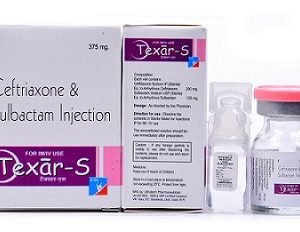Description
Pharmacology
- Pharmacokinetics
Ceftriaxone interferes with the biosynthesis of the peptidoglycan component of the bacterial cell way by binding to and inactivating penicllin-binding proteins (PBPs). Tazobactam is a penicillanic acid sulfone derivative with β-lactamase inhibitory properties. It enhances the activity of β-lactam antibacterials against β-lactamase-producing bacteria.
Distribution: – Ceftriaxone: 98% bound to plasma proteins; crosses the blood brain barrier. Tazobactam:About 30% bound to plasma proteins; widely distributed to tissues and body fluids.
Excretion: – Ceftriaxone: Elimination half-life is about 8.7 hours; 33-67% removed as unchanged drug. Tazobactam: Removed mainly via kidneys with 80% of an administered dose as unchanged drug
- Pharmacodynamics: – Ceftriaxone is a 3rd generation cephalosporin which exerts its bactericidal action against both gram positive & gram negative organisms by inhibiting bacterial cell wall synthesis. Ceftriaxone inhibits transpeptidase & thus prevents cross linking of bacterial cell wall. Transpeptidase & associated proteins constitute various types of specific binding proteins which have affinity for cephalosporins like Ceftriaxone.
Indications: –
- .Lower respiratory tract infections and community-acquired pneumonia.
- . Acute bacterial otitis media.
- . Skin and skin structure infections.
- . Urinary tract infections.
- . Uncomplicated gonorrhea.
- . Pelvic inflammatory disease.
- . Bacterial septicemia
- . Intra-abdominal infections.
- . Bacterial Meningitis.














